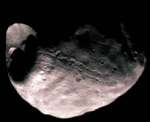
|
Astronomy Picture Of the Day (APOD)
 Dark Bok Globules in IC 2944
Dark Bok Globules in IC 2944
5.10.1995
The dark spots in the above picture are not photographic defects but an unusual type of interstellar cloud known as a Bok globule. Bok globules, named after astronomer Bart Bok who studied them extensively, are small dark clouds made of gas and dust that are typically condensing to form a star or stars.
 CG4: A Ruptured Cometary Globule
CG4: A Ruptured Cometary Globule
4.10.1995
The odd looking "creature" to the right of center in the above photo is a gas cloud known as a cometary globule. This globule, however, has ruptured. Cometary globules are typically characterized by dusty heads and elongated tails.
 The Sun Spews X-rays
The Sun Spews X-rays
3.10.1995
Our Sun is really very hot. The Sun's outer atmosphere is so hot that it emits much light in the X-ray band, which was unexpected. X-rays are usually emitted from objects having a temperature in the millions of degrees, not the mere thousands of degrees of the Sun's surface.
 Deimos: Small Martian Moon
Deimos: Small Martian Moon
2.10.1995
Mars has two tiny moons, Phobos and Deimos. Pictured above is Deimos, the smallest moon of Mars. In fact, Deimos is the smallest known moon in the Solar System measuring only 9 miles across.
 Phobos: Doomed Moon of Mars
Phobos: Doomed Moon of Mars
1.10.1995
Mars, the red planet named for the Roman god of war, has two tiny moons, Phobos and Deimos, whose names are derived from the Greek for Fear and Panic. These Martian moons may well...
 Central Galactic Star Bursts
Central Galactic Star Bursts
30.09.1995
The pictured core of the galaxy NGC 253 shows an exceptionally high rate of star formation. In the center are some of the densest knots of stars ever found, surrounded by glowing gas and dust lanes. Galaxies where such high star formation rates are seen are called "starburst" galaxies.
 An Energetic Radio Galaxy
An Energetic Radio Galaxy
29.09.1995
The radio and optical emission seen in the above superposed images of the radio galaxy 3C368 indicate that energetic processes are at work. A radio galaxy is a galaxy that is visible to radio telescopes. A large radio signal usually indicates very powerful phenomena.
 The International Ultraviolet Explorer
The International Ultraviolet Explorer
28.09.1995
The International Ultraviolet Explorer (IUE) was launched by a NASA Delta rocket in 1978 to provide a space telescope for ultraviolet astronomy. A collaborative project among NASA, ESA and the British SRC (now PPARC) agencies, IUE's estimated lifetime was 3 to 5 years.
 A Venusian Landscape
A Venusian Landscape
27.09.1995
This computer generated view of a Venusian volcano was created using data from NASA's Magellan spacecraft. Magellan used its onboard radar to map the surface of Venus which is hidden from telescopic observations by a perpetual cloud cover.
 A Venus Landing
A Venus Landing
26.09.1995
This image is part of the first color panoramic view from Venus. It was transmitted by a TV camera on the Soviet Venera 13 lander which parachuted to the surface on March 1, 1982.
|
January February March April May June July August September October November |
|||||||||||||||||||||||||||||||||||||||||||||||||